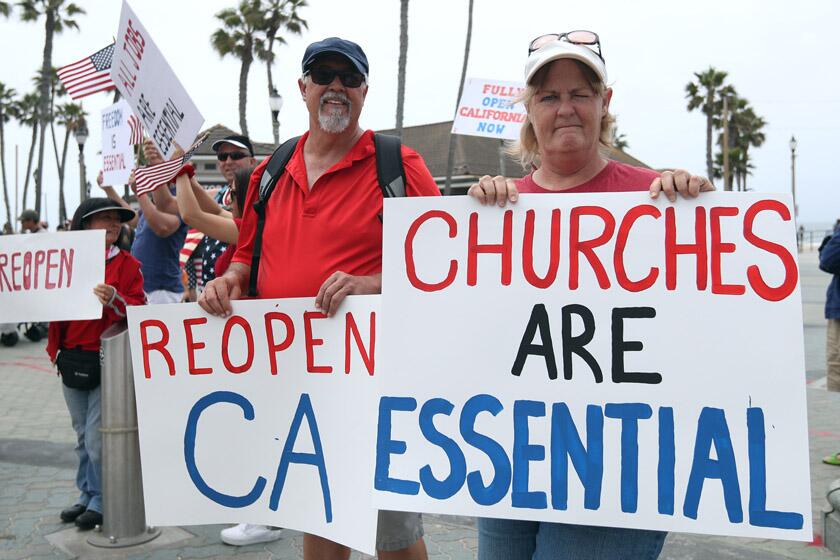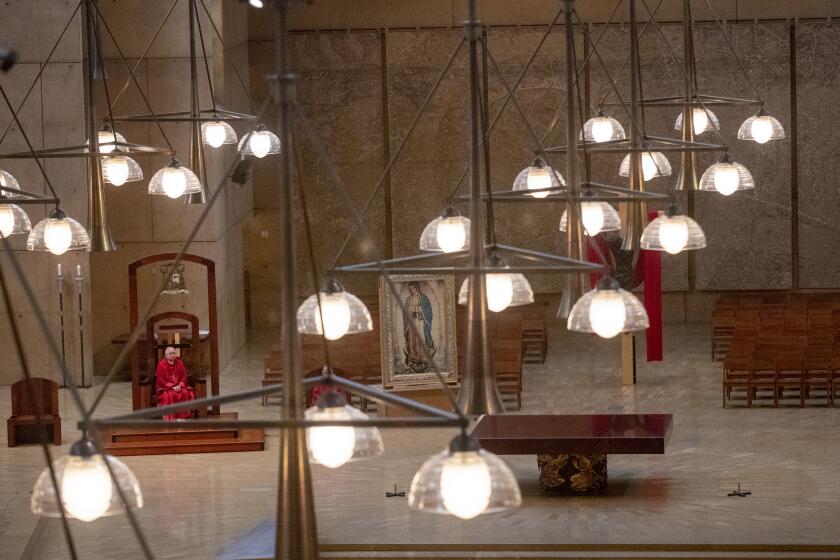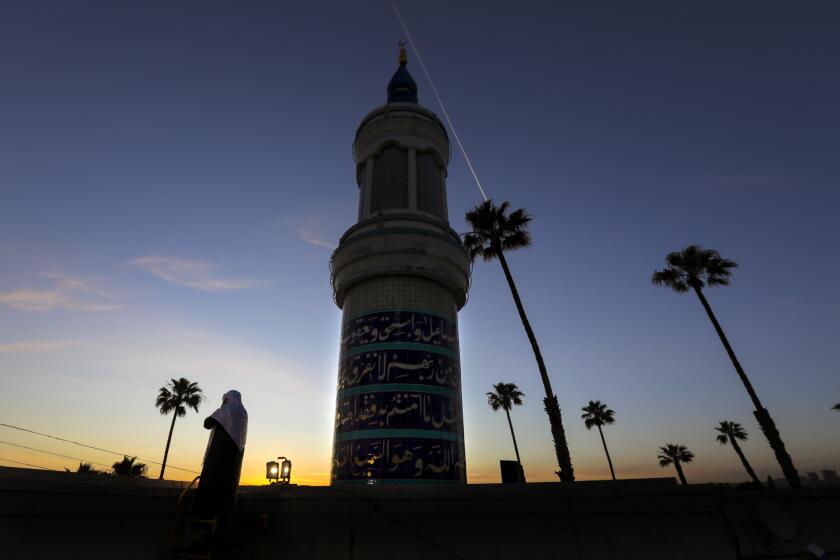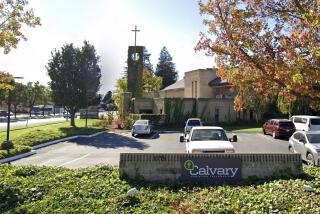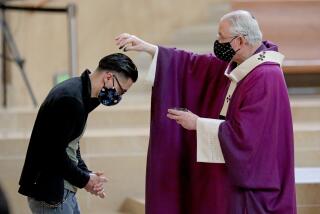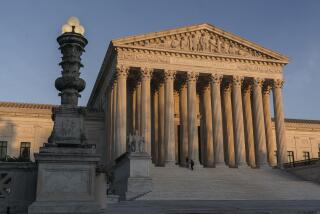California’s battle over reopening churches isn’t over despite new coronavirus rules

- Share via
California’s new plan to allow churches and religious institutions to reopen in the wake of the coronavirus pandemic marks a major step forward.
But it still will alter religious services in dramatic ways, and it’s unlikely to end the push by some churches to allow more regular operations.
Gov. Gavin Newsom has faced lawsuits from religious groups over the stay-at-home rules and has so far been victorious in court.
On Friday night, the 9th Circuit Court of Appeals upheld Newsom’s ban on in-person church services.
“We’re dealing here with a highly contagious and often fatal disease for which there presently is no known cure. In the words of Justice Robert Jackson, if a “[c]ourt does not temper its doctrinaire logic with a little practical wisdom, it will convert the constitutional Bill of Rights into a suicide pact,’” the majority wrote.
But critics say the new rules are still too restrictive.
“An artificial 25% or 100-person limitation on a house of worship is inconsistent with the absence of such limitations on retail establishments,” said Harmeet Dhillon, chief executive of the Center for American Liberty. “Simply put, Gov. Newsom lacks authority to dictate to California’s faithful how they may worship. Guidelines, suggestions, education, and support are all welcome. Secular dictates that do not apply to other categories of our daily lives are not welcome and not constitutional.”
More than 1,200 pastors have signed a ‘Declaration of Essentiality,’ asserting their churches are as essential as any grocery or hardware store and should be allowed to reopen.
Here are some of the basic guidelines:
• Houses of worship must limit total attendance to 25% of a building’s capacity for the first three weeks of services and stop passing offering plates, in addition to taking other precautions.
• Congregants should be screened for fever or other symptoms of illness and are asked to use hand sanitizer and wear face coverings.
• Houses of worship have been told to discourage the sharing of items, including prayer books, cushions and rugs.
• Staff, visitors and congregants are discouraged from singing, holding potluck meals and shaking hands and hugging.
• High-traffic areas, such as chapels and libraries, must be thoroughly cleaned, and common surfaces such as pulpits, pews, altars and donation boxes must be disinfected frequently.
The 13-page document, released by the California Department of Public Health and Cal/OSHA, does not obligate churches, mosques, temples and other houses of worship to resume in-person activity, officials said. In fact, state health authorities strongly recommend that places of worship “continue to facilitate remote services and other related activities for those who are vulnerable to COVID19 including older adults and those with co-morbidities.”
The Justice Department warns that stay-at-home measures enacted by California’s governor may discriminate against religious groups and violate their rights.
Political pressure points
The vast majority of California churches have complied with the stay-at-home order. But there have been some exceptions.
More than 1,200 pastors vowed to hold in-person services on May 31, Pentecost Sunday.
On Friday, President Trump made an unexpected appearance in the White House briefing room to declare that he was designating churches as “essential” businesses so they could immediately reopen.
Trump previously said he would leave decisions about easing public health guidance to states but often criticized decisions by individual governors. The president has now threatened that he will “override” states that don’t heed his directive. It was not clear to which authority he was referring.
Cities across Southern California have allowed mosques to broadcast the call to prayer publicly. But in Culver City, the adhan did not go unchallenged for long.
What’s next?
The occupancy limit for services will remain in place for the first 21 days after a county health department has approved the resumption of religious services and cultural ceremonies within their jurisdiction, the guidance states.
After 21 days, the California Department of Public Health, in consultation with county health officials, will review and assess the effect of the imposed limits and provide further direction as part of a phased-in restoration of activities in places of worship.
Some churches have already announced reopening proposals.
The Roman Catholic Diocese of Orange announced plans for public Masses to resume in phases in Orange County starting June 14.
The first phase includes allowing small groups of healthy people to gather for limited Mass, church officials said Friday in a news release. The second phase will allow for larger groups; the third will permit choirs and social gatherings. All phases will require participants to follow strict guidelines for social distancing and disinfection, officials said.
“The pandemic is far from over, so we will begin with small steps,” Diocese of Orange Bishop Kevin Vann said in a statement. “Realizing that reinfection is a concern, as we saw occurred in Texas and elsewhere, I am asking our pastors to prepare their churches to ensure that these guidelines are followed without exception.”
In Orange County, the bishop’s advisors have been working on reopening guidelines for weeks, in consultation with county officials and medical experts, the release said.
Those older than 65 or who have an underlying health condition will be encouraged not to return when churches initially reopen, as will anyone who is sick or lives with someone who is sick.
Holy-water fonts will remain empty, hymnals will be removed, and people will be instructed not to touch one another, including during greetings. Church rituals that require touching, like the sign of peace, will be suspended.
In most cases, churches will be required to limit their capacity to one-third of normal attendance, officials said. More Masses will be offered than usual, and people will be encouraged to come throughout the week to avoid crowding on Sundays. Vann extended a dispensation from the obligation to attend Mass on Sunday to permit the shift.
The bishop also granted a temporary dispensation allowing priests to celebrate Mass outside of church buildings, including in gyms, parish halls and outdoor spaces.
The Roman Catholic Diocese of San Diego also has begun planning to safely welcome back parishioners.
The diocese has determined that in-person daily Masses can begin June 8, and it set June 14 as the target date for parishes to celebrate Sunday Mass, with significant steps required to enforce social distancing.
The plan is still being developed, taking into account guidance from county and state health officials and the Centers for Disease Control and Prevention.
But it will likely mean big changes, including shorter Masses, protective masks for parishioners, no choir or singing and attendance at 25% to 50% of capacity, among other things, said Kevin Eckery, vice chancellor of the diocese and a spokesperson for the diocese.
“We don’t want people to go back and think it’s just like normal,” Eckery said. “No, it’s going to be the new normal. We are not going to do anything that endangers parishioners and families, or do anything that spreads the virus.”
More to Read
Sign up for Essential California
The most important California stories and recommendations in your inbox every morning.
You may occasionally receive promotional content from the Los Angeles Times.
